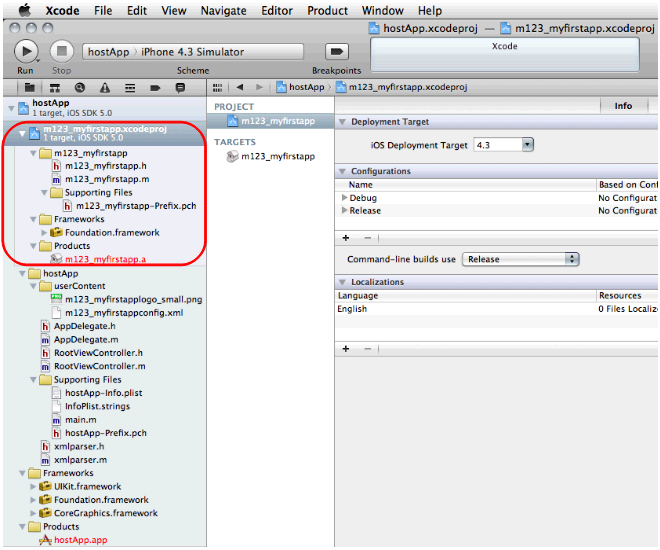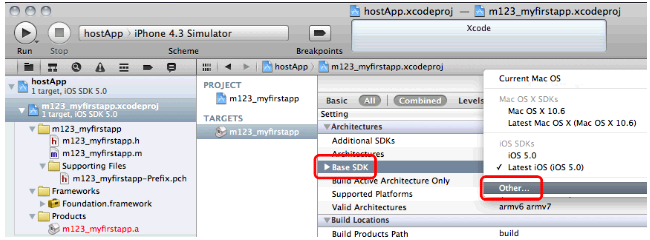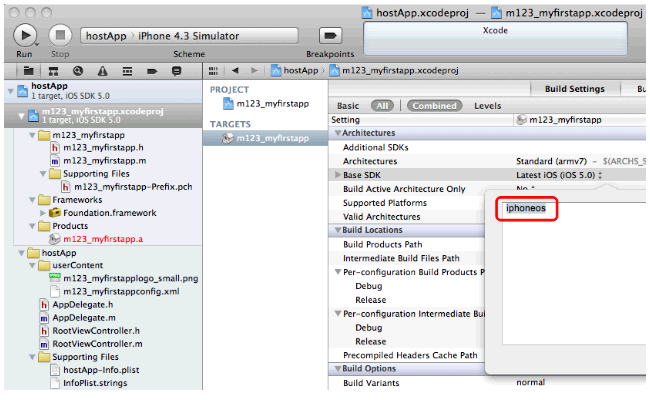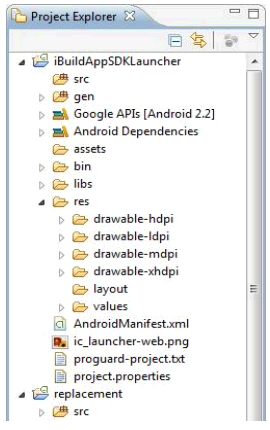Download and Install Android, iOS SDK
(Xcode, mobile app development kit on windows)
Over 150,000 downloads of iBuildApp development kit: SDK for iOS and Android. Supporting xcode on windows
Supported platforms
-
System Requirements
- iOS
- Android
Installation and Configuration
- iOS SDK
- Android SDK
Downloading and Installing
- iOS iBuildApp SDK
- Android iBuildApp SDK
Configuring
- iOS iBuildApp SDK
- Android iBuildApp SDK
Your First iBuildApp Mobile App Feature
- iOS App Feature
- Android App Feature
Web Part Configurations
- Feature Fields Customization
Find Mobile Jobs
This is the place for developers to build, deploy, test and publish their own Extension Features (hereinafter 'Feature') for mobile applications with the iBuildApp platform.
To launch the project, open the hostApp.xcodeproj file - by default, it will open in Xcode:

Fig. 3
The marked area on the image above is the project section where you should allocate your source code.
The basic iBuildApp's application (hostApp project) offers third-party developers the mechanism for integration their functional Extension Features.
Technically, the Extension Feature (m123_myfirstapp.xcodeproj project) is a compiled static library (a file with <.a> extension, a collection of additional resources and a file-list with system libraries and frameworks required for the Feature. Developer who created the Feature should provide (download in iBuildApp.com) the library and all necessary resources. The file-list with system libraries and frameworks is generated on the server when registering the Feature (based on selected options). The library and associated resources will connect to the application during its compilation.
Architecturally, the Extension Feature is a child object of the UIViewController class that pushed into controllers' stack of the host application. Its name should comply with the name of the Feature's entry point (m123_myfirstappViewController). By default the template is set up that way - do not change those settings!)
To set up your environment correctly, select appropriate parameters for the target architecture depending on whether the library is compiled for iOS simulator or for real device - in the Architectures section, pick iphoneos (for real device) or iphonesimulator (for iOS simulator) for the target assembly (Fig. 4, 5):

Fig. 4

Fig. 5
The iBuildApp SDK requires that project files follow this convention:
- Resource file names should start with Feature ID, i.e.
m123_myfirstapplogo_small.png.
- The static library file created during the Feature compilation should have exactly the same name as the Feature ID, with <.a> extension (by default the template is set up that way - do not change those settings!):
m123_myfirstapp.a
To launch the project, copy extracted folders into Eclipse IDE's Workspace:

Fig. 3
The basic iBuildApp's application (iBuildAppSDKLauncher project) offers third-party developers the mechanism for integration their functional Extension Features.
Technically, the Extension Feature (m123 project) is an android library, a collection of additional resources and a file-list with system libraries and frameworks required for the Feature. Developer who created the Feature should provide (download in iBuildApp.com server) the library and all necessary resources. The file-list with system libraries and frameworks is generated on the server when registering the Feature. The library and associated resources will connect to the application during its compilation.
Each Feature's Activity is a child object of the AppBuilderWidget class that inherits the Activity class. The name of the main Activity should comply with the name received from the server. By default the template is set up that way - do not change those settings!)
The iBuildApp SDK requires that project files follow this convention:
- Resource file names should start with Feature ID, i.e.
m123_small.png
- All ID in layouts should start from the prefix.